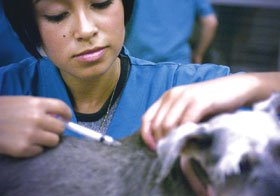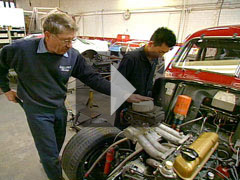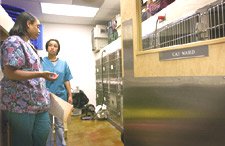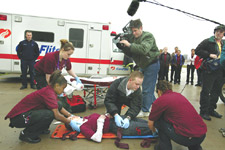High School’s New Face: Can Smaller Be Better?
No longer limited to the classroom, educators move to close the gap between school and the real world.
Your content has been saved!
Go to My Saved Content.
For Paula Pereira, middle school was more about fighting than it was about learning. It was more about getting by and fitting in than about being prepared and feeling connected.
When it came time for high school, the teen from Oakland, California, feared more of the same -- more fights, more disruptive classes, more precious days, weeks, and months of her education wasted. "There were too many gangs and fights every day," she said of her middle school years. "I didn't want that."
As the quiet, resolute teenager headed into the spring of her eighth-grade year, she discovered a bright spot in her otherwise dismal school life: choice. Instead of being sentenced to a large, failing high school nearby, Pereira and her family had options for how and where she would spend the next four years.
Pereira didn't want to go to her neighborhood's 2,000-student high school -- it was too violent. Instead, she and her family chose a small new school called Met West, one of thousands of high schools throughout the United States that typically serve between 200 and 600 students, rather than the 2,000 or more many high schools cram in. Instead of being merely a face in a crowd, Pereira would be one of just thirty-four students in the school's first freshman class. She would work at an internship two days a week (a cornerstone of the Met model) and, with her teachers and parents, she would devise a personalized four-year education plan.
Met West, modeled after the much celebrated Metropolitan Regional Career and Technical Center in Providence, Rhode Island (also known as the Met), doesn't look or feel like a typical high school. There are no Friday-night football games or afterschool clubs. There's no cafeteria where students hang out with friends before and after school. In fact, in its first year, the Met West "campus" consisted of just one classroom at nearby Laney College, a two-year community college. (The school now occupies several rooms in a school-district office building down the street from Laney.)

Running Time: 8 min.
Pereira's school schedule is just as unorthodox as the campus. Two days a week, she puts on pastel scrubs and takes the bus to the Broadway Pet Hospital in downtown Oakland, where she administers vaccines, trims nails, cleans cages, and helps care for the dogs, cats, and other animals the hospital treats. Her mentor is a veterinary technician named Verena, who works with Pereira and her teachers to build connections between classwork and the internship and to design projects that help Pereira further key academic skills, like researching, writing, and data analysis.
When Pereira's not tending to animals, she's taking courses at Laney and at Met West, where she also spends several hours a week with her advisory group, a small team of students and one teacher who remain associated throughout the four years of high school. She calls her teachers, even her principal, by their first names, freely comes and goes to and from school like an employee passing from the office to lunch to an afternoon meeting, and, with the help of her peers, her teachers, and her family, has taken control of her own learning.
"Here, I tell you what I want to learn about, and I do my work," says Pereira, describing an experience that is a marked contrast to the time she spent in middle school. "It's changed me a lot," she adds. "I wake up in the morning and say, 'Hey, I'm going to school today.' School ends at 3:30, but I'm always here after that. I love this place."
Credit: Bart Nagel
A Failing Institution
Pereira -- and hundreds of thousands of teenagers like her throughout the country -- are at the vortex of the most far-reaching high school reform effort in a half-century. In the late '50s, Harvard University president James Bryant Conant advanced the notion that teenagers and society alike are best served by large, comprehensive high schools populated by students from a wide variety of backgrounds.
Nearly five decades later, however, educators nationwide are rethinking Conant's model, which continues to be the standard design of high schools throughout the country. From New York to California, from Texas to Illinois, school districts are taking a hard look at who is -- and, more important, who isn't -- being served by high schools. Increasingly, they are devising new strategies and new institutions to meet the needs of all students. Although much of the attention focuses on breaking up large schools and creating small ones, the efforts are as much about changing the sum and substance of high school as they are about shrinking a school's size.

The disconnect between real life and the high school experience and the absence of any real connection to peers and teachers causes many students on the margins to give up: More than 30 percent of U.S. students who enter high school never finish, according to a recent report by Harvard University's Civil Rights Project, the Urban Institute, Advocates for Children of New York, and the Civil Society Institute.
Minorities are especially hard hit. Although graduation rates for whites average 75 percent, only about half of African Americans, Latinos, and Native Americans graduate. And what about the students who do walk across the stage? Only 39 percent go on to college, and a mere 18 percent will earn a degree within six years, according to the National Center for Higher Education Management Systems.
Why the distressing statistics? Although a host of societal issues contribute to the dropout rate, most critics also blame the schools. "Today's high school is wrong in every way," says Tom Vander Ark, executive director of the Bill and Melinda Gates Foundation's multimillion-dollar education initiative. "It's the wrong mission, the wrong architecture, the wrong curriculum, and the wrong instructional model. This is not a problem you can address by tinkering with the old model."
Like building inspectors preparing to condemn an aging and unsafe structure, high school reformers tick off a list of structural flaws: The typical fifty-minute class period doesn't allow enough time for projects or thoughtful work. Massive campuses with thousands of students are impersonal and unsafe. The department structure isolates teachers and prevents them from working with one another on cross-disciplinary projects that would be more meaningful and interesting to students. Four years of high school isn't enough "catch-up time" for students who enter ninth grade not speaking English or who lack strong reading and math skills. Parent involvement is often limited to booster clubs and back-to-school nights.
"The one-size-fits-all high school was built for a different time," says Hilary Pennington, vice chair and cofounder of Jobs for the Future, which advocates for systemic high school reform. "Why can't it be something we look at differently?"

Dropout statistics, disengaged youth, a poorly prepared workforce -- all these factors have come together to create a flurry of activity around new small schools. In some cities, like Los Angeles, Chicago, and New York, small schools are a central part of the district's reform effort. Elsewhere, they're mostly targeted fox "at risk" students.
An estimated 1,500 new small schools have opened as part of the Gates Foundation initiative, and, thanks to additional private, federal, or local dollars, thousands more are springing up. Some schools, like Independence High School Academy of International Studies, in Charlotte-Mecklenburg, North Carolina, or the Bushwick School for Social Justice, in Brooklyn, are built around themes. Others are based on pioneering models, like the Big Picture Company's Met schools (in Oakland and other cities) or High Tech High, which began in San Diego and has since been replicated in several other California cities.
One of the guiding principles for all these schools is the notion that smaller is better, especially for students who have historically been left behind either because of race, class, or academic abilities. One of the chief benefits proponents identify is the ability of students and teachers to forge deep, meaningful relationships.
"Even in crappy small schools, the stuff about relationships is automatic," says Michelle Fine, a distinguished professor of social psychology at the City University of New York's Graduate Center. Fine has been involved in smallschool efforts in New York, Chicago, and Philadelphia for fifteen years. "You're respected by your peers. People know your name," she adds. "They miss you when you're not there."
Rosa Fernandez, an immigrant from the Dominican Republic who graduated from New York City's Manhattan International High School, put it this way in The Schools We Need, a publication by and for high school students produced by the nonprofit organization What Kids Can Do: "Small schools are perfect for teenagers, because we need people to be warm and care about us, to be after us -- otherwise, we might take the wrong road."
Small schools generally have higher attendance rates and lower dropout statistics than their larger counterparts, but size alone doesn't guarantee that the hours spent in school will leave students better prepared for life after high school. For that, says Fine and others, schools need to think about restructuring the school day, creating longer classes, and allowing time for sessions in which students and their teachers get to know one another and tackle academic and personal issues. Perhaps most important, they need to create a community of teachers who are committed to "doing whatever it takes" to serve all students.
More Work Needed
For all the activity and buzz in and around new small schools, only 10 percent of all high school students in the country have been affected by the reform efforts, according to Naomi Housman, executive director of the National High School Alliance. The only way to materially change the high school experience, she and others argue, is to do the long and difficult work of converting large high schools into small schools or smaller learning communities. It's a huge task -- and one the general public isn't quite ready for.
Though students in small schools are mostly positive about their experiences, the vast majority of students and families aren't ready to let go of their vision of the all-American high school -- regardless of how dysfunctional it may actually be.
"Americans have a love affair with the traditional high school," says Housman. Communities take great pride in championship football teams and show-piece libraries, media centers, and performing-arts centers, and they are loathe to give them up, particularly when the hard evidence about the benefits of small schools is still years away.
Consider this: In 2003, $4 billion was spent on high school construction. The largest quartile of new schools were designed and built for 1,700-2,700 students -- as much as three times what small-school advocates argue is optimal. Part of the allure is financial -- districts have long assumed that large complexes are more cost efficient to build and maintain -- but recent studies have pointed to greater long-term cost savings with smaller schools.
For the Gates Foundation's Tom Vander Ark, signs of progress are everywhere, but plenty of heavy lifting has yet to be done. He points to three critical milestones that together would constitute a radical change: "thousands of really good schools, dozens of districts that have dramatically improved student outcomes, and three to four states that have moved the needle on graduation rates and college attendance."
If the hard work continues, he adds, "we could hope to achieve them by the end of the decade."
Roberta Furger is a contributing writer for Edutopia.
LEARN MORE
High Schools An up-close look at innovative high schools throughout the country, together with information about the organizations leading the way in high school reform. You'll find feature articles, video documentaries, and multimedia stories, as well as links to useful resources and organizations.
A New Way of Learning

What are some of the newest strategies for reinvigorating high school education? Not surprisingly, they're slightly different in every community. But several core goals stand out. ...read more and watch a video.
Want to Know What's Wrong with Schools? Ask the Customers.
What's the first thing a company does when it starts to founder? It talks to its customers, of course. It's a fundamental practice in business, but it's disturbingly rare in the education community.
"People didn't even begin to think about asking students until about two years ago," says Barbara Cervone, director of the nonprofit organization What Kids Can Do, which works with students to highlight their concerns around high school reform. In many districts, she notes, students are the last to know they're going to be attending a small school. That's a recipe for disaster, Cervone says, because no matter how beneficial a small school is, students need to feel respected and part of the reform process.
The Indianapolis Public School District is one entity that has gone to great lengths to make sure youth are included in all aspects of the discussion around school reform. The district, which has a large poor, minority student population and a dropout rate of more than 50 percent, is on the fast track to small schools. Its five high schools were divided into small learning communities for the first time this year and will further evolve into small schools in the 2005-06 school year.
Luke Kashman, a sophomore at Indianapolis's Arsenal Technical High School, was one of the first students to be involved in the reform initiative. He initially signed on "as a way of getting out of class for the day," he says with a laugh, but after the first meeting, he realized he wanted to be involved in the process for the long haul.
"It's changed the way I think about high school," says Kashman. "Up until this point, I had looked at high school as something to get through, to prepare me for college. Now, I realize high school can be a community -- a place where all students feel responsible for one another."
At first, Kashman says he was worried teachers wouldn't be receptive to the students' ideas. "But when we didn't feel they understood, we stopped and told them that they'd misunderstood us.
"I got the feeling that they really did listen," he recalls, still amazed at the exchange. "And isn't that the whole reason for doing this -- to make sure adults and students are talking and listening to one another?" --R.F.
Keeping Reform Afloat
Transforming high schools has been likened to turning an ocean liner around: It involves slow progress seemingly measured in inches, rather than yards or miles. Here are just a few of the icebergs that could sink the reform ship.
Accountability: Proponents of high school reform are calling for new measures of accountability that broaden assessments to reflect new styles of teaching and learning, reward and acknowledge schools that are building a strong foundation of skills, and support schools with nontraditional models, such as those that allow students up to six years to complete high school.
Teaching: From better preparing high school teachers to teach literacy to providing time for educators to have meaningful discussions about student needs and abilities, the professional piece of the equation is huge. If schools become smaller but don't include structural changes necessary to support new methods of teaching and more personalized instruction, academic gains will likely fall short of the mark.
Time: From rethinking how we structure the school day to the notion that high school should be completed within four years, most small-school pioneers are finding that traditional high school schedules don't provide the time or space for creative teaching and learning. They're scrapping the bell schedule and implementing more flexible systems that can better address students' academic and personal needs and provide time for meaningful dialogue and work among teachers.
Community: Too often, communities are being left out of the loop when it comes to high school reform -- or are being included only after the details of a school-redesign plan have been formulated. That's too little and too late, say reform advocates, if the changes are to be meaningful and long lasting. --R.F.